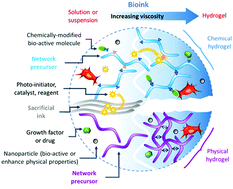Chemical insights into bioinks for 3D printing
Abstract
3D printing has triggered the acceleration of numerous research areas in health sciences, which traditionally used cells as starting materials, in particular tissue engineering, regenerative medicine and also in the design of more relevant bioassays for drug discovery and development. While cells can be successfully printed in 2D layers without the help of any supporting biomaterial, the obtainment of more complex 3D architectures requires a specific bioink, i.e. a material in which the cells are embedded during and after the printing process helping to support them while they are arranged in superimposed layers. The bioink plays a critical role in bioprinting: first, it must be adapted to the 3D printing technology; then, it must fulfil the physicochemical and mechanical characteristics of the target construct (e.g. stiffness, elasticity, robustness, transparency); finally it should guarantee cell viability and eventually induce a desired behaviour. This review focuses on the nature of bioink components of natural or synthetic origin, and highlights the chemistry required for the establishment of the 3D network in conditions compatible with the selected 3D printing technique and cell survival.



 Please wait while we load your content...
Please wait while we load your content...